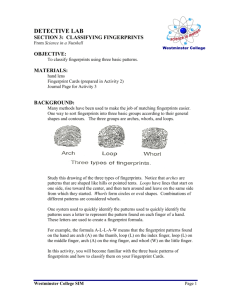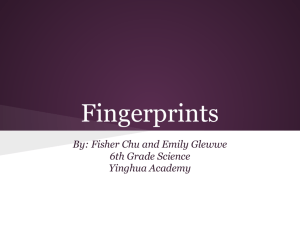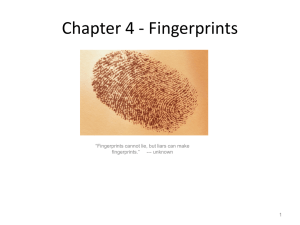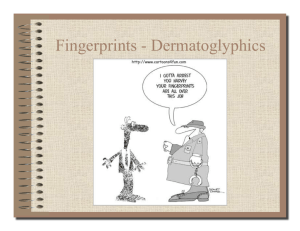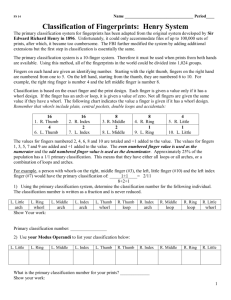Classification of Fingerprints
advertisement
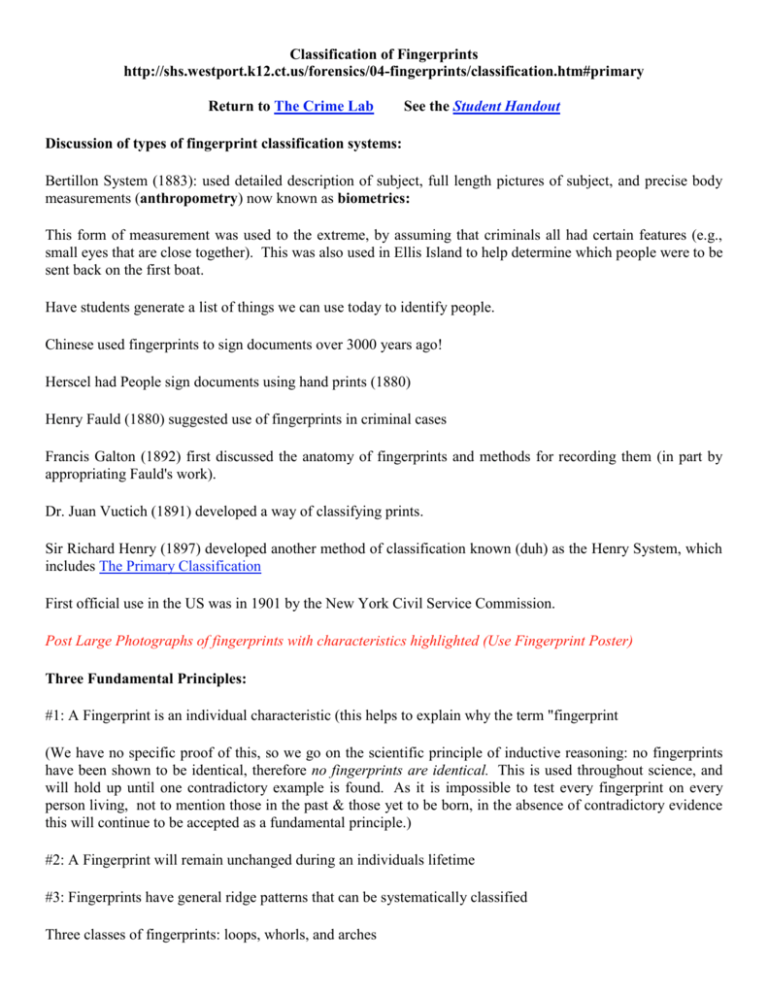
Classification of Fingerprints http://shs.westport.k12.ct.us/forensics/04-fingerprints/classification.htm#primary Return to The Crime Lab See the Student Handout Discussion of types of fingerprint classification systems: Bertillon System (1883): used detailed description of subject, full length pictures of subject, and precise body measurements (anthropometry) now known as biometrics: This form of measurement was used to the extreme, by assuming that criminals all had certain features (e.g., small eyes that are close together). This was also used in Ellis Island to help determine which people were to be sent back on the first boat. Have students generate a list of things we can use today to identify people. Chinese used fingerprints to sign documents over 3000 years ago! Herscel had People sign documents using hand prints (1880) Henry Fauld (1880) suggested use of fingerprints in criminal cases Francis Galton (1892) first discussed the anatomy of fingerprints and methods for recording them (in part by appropriating Fauld's work). Dr. Juan Vuctich (1891) developed a way of classifying prints. Sir Richard Henry (1897) developed another method of classification known (duh) as the Henry System, which includes The Primary Classification First official use in the US was in 1901 by the New York Civil Service Commission. Post Large Photographs of fingerprints with characteristics highlighted (Use Fingerprint Poster) Three Fundamental Principles: #1: A Fingerprint is an individual characteristic (this helps to explain why the term "fingerprint (We have no specific proof of this, so we go on the scientific principle of inductive reasoning: no fingerprints have been shown to be identical, therefore no fingerprints are identical. This is used throughout science, and will hold up until one contradictory example is found. As it is impossible to test every fingerprint on every person living, not to mention those in the past & those yet to be born, in the absence of contradictory evidence this will continue to be accepted as a fundamental principle.) #2: A Fingerprint will remain unchanged during an individuals lifetime #3: Fingerprints have general ridge patterns that can be systematically classified Three classes of fingerprints: loops, whorls, and arches Loops: 60-65% of the population has loops Must have one or more ridges entering from one side of the print, curving and exiting from the same side Loop opening toward little finger: ulnar loop (As the ulna is the medial bone) Loop opening toward thumb: radial loop (As the radius is the lateral bone) Type lines are ridges that diverge (separate) Deltas are located at the point of divergence. All loops must have one delta The core is the center of the loop Whorls: 30-35% of the population has whorls All whorl patterns must have type lines and two deltas Four major types: plain, central pocket, double loop, accidental Plain whorls must have at least one ridge that makes a complete circuit, and an imaginary line from one delta to the other must touch a whorl ridge Central pocket whorls must have at least one ridge that makes a complete circuit, and an imaginary line from one delta to the other cannot touch a whorl ridge Double loop is two loops combined to make one whorl Any other types not in the three categories are called accidentals (generally, they have a whorl type pattern, which is why they are in the whorl grouping) Arches: Only 5 percent of the population has arches Arch ridges tend to enter from one side of the print and leave out the other side Two distinct types-- plain arches and tented arches Plain arches tend to show a wave like pattern Tented arches show a sharp spike at the center of the arch Arches do not have type line, deltas or cores Using the information above, here are some examples of each of the major fingerprint types: Taken from http://www.fingerprints.tk/ The Primary Classification (of all Ten Fingers) This is a version of the Henry system, and is the first classification used by the FBI to "whittle down" the possible suspects in a crime The fingers are paired, placing one finger in the numerator of a fraction and the other in the denominator. This way all ten fingers can be paired. R. Index R. Ring L. Thumb L. Middle L. Little ------ ------ ------ ------ ------ R. Thumb R. Middle R. Little L. Index L. Ring If a whorl pattern is found on the first pair of fingers (R. Index/R. Thumb), it is given a value of 16. A whorl on the next pair would be given a value of 8. The next pair, 4, then 2, then one for the last pair. Arches and loops are valued at 0. Just so the fractions don't end up with 0 in the numerator or denominator, we will add 1 to the top and bottom of the fraction. Ex: If a whorl was found on the R. Index finger and the R. Middle finger, the following fractions would result: 16 + 0 ------ + 0 ------ 0 + + 0 ------ 8 + + ------ 0 + 0 0 ------ + 0 If we add 1 to the top and bottom, we end up with a fraction of 17/9. 16 + -----0 0 + -----+ 8 0 + -----+ 0 0 + -----+ 0 0 + -----+ 0 1 ------ + 1 Therefore, we can eliminate all suspects that do not have this fraction. This is not the be all and end all of fingerprinting classification. It is simply a way of quickly classifying fingerprints of a large group of subjects. Determine the Primary Classification of your prints ONLINE! Unfortunately, most of the time, the criminal will be not cooperative enough to leave all ten fingerprints at the scene of a crime. So what to do? The only way to solve this problem is to look at specific characteristics of a particular fingerprint (a.k.a. fingerprint minutia) Basic and composite ridge characteristics (minutiae) Minutiae ridge ending Example Minutiae bridge bifurcation double bifurcatio dot trifurcation island (short ridge) opposed bifurcatio lake (enclosure) hook (spur) Taken from http://www.policensw.com/info/fingerprints/finger08.html ridge crossing opposed bifurcation/ridg Page Design © Ian Hunter. You can see the minutiae applied to a specific fingerprint in the image below: This image is from http://perso.orange.fr/fingerchip/biometrics/types/fingerprint.htm In some cases, this meant that an investigator had to go through all of the known fingerprint cards by hand, one by one! Some smaller jurisdictions had individual fingerprints on each card, and each card was classified. However, in larger areas this got to be too cumbersome. This ultimately led to the development of the AFIS database . . . More Fingerprint Information: http://www.ridgesandfurrows.homestead.com/ Fingerprint Samples & How to Classify Them Return to The Crime Lab Loops, Arches, and Whorls: (Yes, it's the LAW!) - A Prelude to Primary Classification Loops A Loop starts and ends at the same side, which is the side of the opening. Arches An Arch goes from one side to another. One Delta, on the opposite side of the loop's opening. NO Deltas. A Whorl is roughly circu Two Deltas, All Images above were taken by Mr. Lazaroff NOTE the location of the Radius (thumb side; thumb = finger #1) vs. the Ulna (pinky side; pinky = finger #5) The direction of the opening of the loop is classified in terms of whether it opens toward the thumb or the little finger (rather than left or right); the name of that type of loop comes from the bone on that side of the lower arm (the radius and ulna). Based upon this, classify each of the prints below in terms of whether the print is a radial loop vs. an ulnar loop. ____________________________ ______ Classifying Prints, Part I: Primary Classification A great resource for classifying prints: http://www.policensw.com/info/fingerprints/finger07.html Many of the images that follow are from that site. First of all, we need to know the three basic types at the top of this sheet. There are, however, some important general variations for each type. We mentioned radial and ulnar loops above. Arches also vary in that some have a central peak that "supports" the arch, and looks for all the world like a tent pole. This is where the name "tented arch" comes from. versus Plain Arch Tented Arch From: http://www.policensw.com/info/fingerprints/finger07.html Whorls, on the other hand, are more complex. A whorl is always characterized by at least two deltas (and whorls with more than two are specifically called accidental whorls). The key to a true whorl is that an imaginary line drawn from delta to delta intersects a whorl line. What follows are some variations of whorls: Plain Whorl Central Pocket Whorl Double Loop From: http://www.policensw.com/info/fingerprints/finger07.html The Primary Classification (The Henry System): In order to start classifying your set of prints, lets look at the group, as a whole. In the table below, classify each of your ten prints as to whether they are Loops, Arches, or Whorls by CIRCLING THE APPROPRIATE LETTER BELOW EACH PRINT. R. Thumb R. Index R. Middle R. Ring R. Litt L or A or W L or A or W L or A or W L or A or W L. Thumb L. Index L. Middle L. Ring L or A o L. Litt L or A or W L or A or W L or A or W L or A or W L or A o Do you have any whorls? Whether or not you have them, and where you have them, will allow us to categorize your group of 10. First of all, the grouping is as follows, to form 5 pairs: NOTE: The ten prints as arranged on the print card, and the table above, are NOT in the same order as the Henry Table below. CIRCLE ON THE TABLE BELOW, ANY OF YOUR FINGERPRINTS THAT HAVE WHORLS. R. Index R. Ring L. Thumb L. Middle L. Litt ------ ------ ------ ------ ------ R. Thumb R. Middle R. Little L. Index L. Rin 16 8 4 2 The presence of a whorl in any of the pairs above earns the value below the pair (i.e., a whorl on the Right Ring finger earns an 8 in the numerator, whereas a whorl on the left index finger earns a 2 in the denominator. The absence of a whorl -- in other words you have either a loop or an arch -- earns a zero for that finger.). Unlike actual fractions, we will be adding the numerators and the denominators, so it is best not to think of these as actual fractions! We will also add a one to both numerator and denominator to get the final "fraction" classification. USING THE FINGERS YOU CIRCLED IN THE TABLE ABOVE, ENTER THE NUMBER FOR EACH FINGER IN THE TABLE BELOW, AND CALCULATE YOUR SCORE TO THE RIGHT. Write your score on the board, and see if there is anyone else in the room with the same score. Right Index Right Ring + ------ Left Thumb + -----+ Left Middle + -----+ -----+ Added Automatically Left Little + + ------ + 1 1 ------ + 1 Added Automatically Right Right Right Left Left Thumb Middle Little Index Ring There are 1024 possible groupings. About 25% of the population has no whorls; they have only loops and arches. Do you know what score they would have? Write the fraction here: ____ / ____. As each score is unique, we can also use the scores, as we will see in class, to figure out which fingers have whorls. Can we say that the fingers without whorls definitely have loops? Why or why not? Do the calculations ONLINE: http://shs.westport.k12.ct.us/forensics/04-fingerprints/henry_system.htm Classifying Prints, Part Deux: Minutiae - Secondary Classification Actual identification of a fingerprint as individual characteristic is based on the tiny details of the print, known as minutiae. Basic and composite ridge characteristics (minutiae) Minutiae ridge ending 1 Example Minutiae bridge bifurcation 2 double bifurcation dot 3 trifurcation island (short ridge) 4 opposed bifurcations lake (enclosure) 5 ridge crossing hook (spur) 6 opposed bifurcation/ridge endin Taken from http://www.policensw.com/info/fingerprints/finger08.html Page Design © Ian Hunter.| Now let's look at the print on the left to see some of the minutiae (find the crease in the finger, and at least one other ridge ending): First classify the typ label This image is from http://perso.orange.fr/fingerchip/biometrics/types/fingerprint.htm Pores & Spots between the Friction Ridges: Tertiary Classification Another way to identify prints is to look carefully at the details on and between the ridges. The image above left shows some of the detail in terms of the location of the sweat pores. For example, in addition to the sweat pore labeled above ("pore"), look at the line for the delta. There is an angled ridge at the end of the line, and if you look carefully, you can see that there is a sweat pore exactly at the angle of the ridge. Below left, there is a print in which you can fine spots between the friction ridges. The plastic print below right (an impression made in soft wax) shows the details one can find between the ridges.



